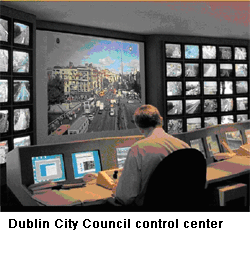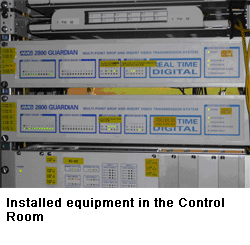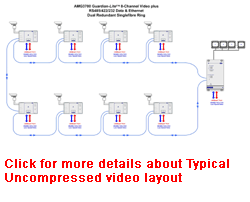Dublin City Council monitors over a 160 CCTV cameras from a 24 hour control centre situated close to the City centre. The video images from these cameras are shared with a number of other agencies with the Greater Dublin area including surrounding local authorities, the police and emergency services and the National Roads authority.
Dublin City Council monitors over a 160 CCTV cameras from a 24 hour control centre situated close to the City centre. The video images from these cameras are shared with a number of other agencies with the Greater Dublin area including surrounding local authorities, the police and emergency services and the National Roads authority.
Dublin City Council has installed a high speed Ethernet ring on the motorway and approach roads but has chosen to use digital uncompressed video transmission networks for the CCTV and traffic signals in the city rather than use compressed video. While some installations of CCTV over IP have taken place, the policy is to utilize uncompressed video to provide the images back to the control centre such that as much as possible the images are available for further transmission or conversion as required.
Dublin City Council had also begun to invest in the provision of fibre optic routes  throughout the city and along the Motorway network for a variety of reasons:
throughout the city and along the Motorway network for a variety of reasons:
1. Cost of leased Telecom lines for CCTV use and the cost of annual fees for Traffic Signal controllers, as well as delays in completing installations.
2. Development of Quality bus network and the requirement that all QBC routes should have CCTV coverage for monitoring purposes
3. Development of the Light rail network and the additional requirements of tram priority at 40 locations.
4. Building of the Dublin Port Tunnel and the requirements for Heavy Goods Vehicle Management.
What type of transmission system is required for good CCTV management?
An analogue system similar to that in operation in the city centre for some years was first assessed, however this involved using a large number of cores and the distance even for single mode units was at the limit of the optical bandwidth. While this type of system had been in operation since the late eighties, it was not a managed transmission system and it offered no resilience in terms of equipment failure.
As such it was felt that it could not meet the requirements of motorway monitoring and the 24* 7 requirements which arise from this type of operation. The other important consideration of this type of system was that it offered no serial or Ethernet ports.
Network CCTV
 The development of video compression technology and the resulting reduction of the bandwidth required for transmission, has made possible the use of Ethernet or ATM networks for CCTV transmission. However this type of system does have a number of drawbacks which must be realistically assessed when determining the type of system to implement.
The development of video compression technology and the resulting reduction of the bandwidth required for transmission, has made possible the use of Ethernet or ATM networks for CCTV transmission. However this type of system does have a number of drawbacks which must be realistically assessed when determining the type of system to implement.
For CCTV monitoring the basic requirements could be summed up as follows:
1. Always on CCTV with no switch delay during camera selection
2. Multiple operators and agencies require access without degradation of the images.
3. As close as possible to zero latency when operating the Pan Tilt and Zoom (PTZ) controls.
4. Allows the use of video analysis software
5. Operator fatigue if images are not high quality.
A traffic application, particularly a motorway one, means that there is constant motion within the video image, the operator must be able to zoom in on a problem area and this will mean that whatever compression technique is utilised it must be able to deal with a large amount of pixel changes from one image to another.
During the compression process, some information within the video signal is discarded and equally clearly this information cannot then retrieved if off line analysis is required, this in effect means that the demands of the compression methodology and any bandwidth limitations have more bearing on the received video than any inherent Video requirements.
The use of CCTV for urban and motorway control provides for the following:
- Speedy response to any incidents
- Monitoring and adjustment of operation of traffic signals
- Bus lane monitoring
- Roadworks Control
- Vehicle tracking
- Driver information systems

Video Compression
In order to transmit CCTV images over a network some form of compression is needed as an uncompressed video signal requires ~ 130Mb Compression used therefore in order to be able to use the IP Ethernet network on the motorway. Compression can bring the bandwidth requirements down to between 25Mbit/s to 64Kbit/s depending on the video requirements and the bandwidth available.
Video compression attempts to discard any information which is not necessary for the viewing of the final image, and typically the compression algorithm would be looking at changes within a frame and also from frame to frame. As the scene content increases, as in the case of a high speed motorway monitoring, then the bandwidth requirements increase and this can be further increased if there is to be very low latency for the use of PTZ controls. The more active the monitoring of a motorway and the more an operator uses a camera then the bandwidth increases and the more operators or agencies that require access to the images then this will in general increase the overall network bandwidth which needs to be taken up by the CCTV transmission.
These traditional limitations of CCTV over IP are well documented however specifically for wide area monitoring of CCTV there are several other limitations which need to be taken into account.
If the delay between using a control and seeing the camera image respond is in excess of 250 ms it makes a system extremely difficult for an operator to use over an extended period. Using compression can result in latencies in excess of this figures at a time when it is needed least i.e. when there is an incident.
The design of a network topology is crucial to how reliant the system is, however this is not a trivial task and certainly for the number of cameras required in Dublin it requires far greater expertise than a conventional network.

An IP network has to be maintained and again this is an overhead that has to be taken into account, a very important factor though is that the use of a distributed network over a long distance as in the case of a motorway throws up the issues of security of the main network. The network must provide segmentation using VLANS, considerations such as the speed of recovery of nodes for redundancy must be carefully assessed. However it is the requirement to have a highly skilled design and maintenance support for these systems which can cause the most problems as traffic networks are by their nature 24 hour 7 day a week operations and a failure of the system can occur at any time.
The use of third party analysis software is a major factor for a traffic management system, video detection systems require high quality images to analyse and these will not work properly on a compressed video stream. This in turn means that the video detection system must be located beside the cameras in the field thus requiring additional hardware and maintenance overheads.
Uncompressed Video Transmission networks
Digital uncompressed video transmission using drop and insert circuits has the benefits of standard network capabilities but does not compromise the video except that which occurs when any analogue signal is converted to a digital one, however the effects of the this can be limited by choosing a sufficiently high number of quantisation bits. A drop and insert circuit is simply a daisy chain of transmission nodes where each unit is connected typically by 1-2 fibres. At each node a number of video channels can be inserted and this can vary from a single channel upwards making it particularly useful for traffic monitoring.
The use of this technology means that a transmission ring can be put in place which provides redundancy but does not require any network skills to put in place. In the event of a failure of a node the ring can ¨self heal ¨ ensuring that the other CCTV inputs are unaffected, the repair of the node is a simple replacement and configuration of the channel numbers.
This type of equipment also offered a network channel and serial ports, this means that it is possible to connect traffic controllers and IP devices on to these devices thus maximising the use of the transmission equipment.
A typical configuration is shown here where 8 channels of video are provided two at each location as well as an Ethernet capability and serial ports. The network developed is a managed system using SNMP thus allowing connection to the main Fault Management System for automatic notification of loss of video or data as well as node failure.
Conclusion
When considering CCTV systems for applications such as urban and motorway working it is important to ensure that the transmission system used does not have adverse consequences for the future. If the incorrect medium is chosen then this could seriously limit the quality of CCTV images displayed as well as the use of any scene analysis software which may need to be deployed in the future.
Product Adopted:Surveillance Cameras